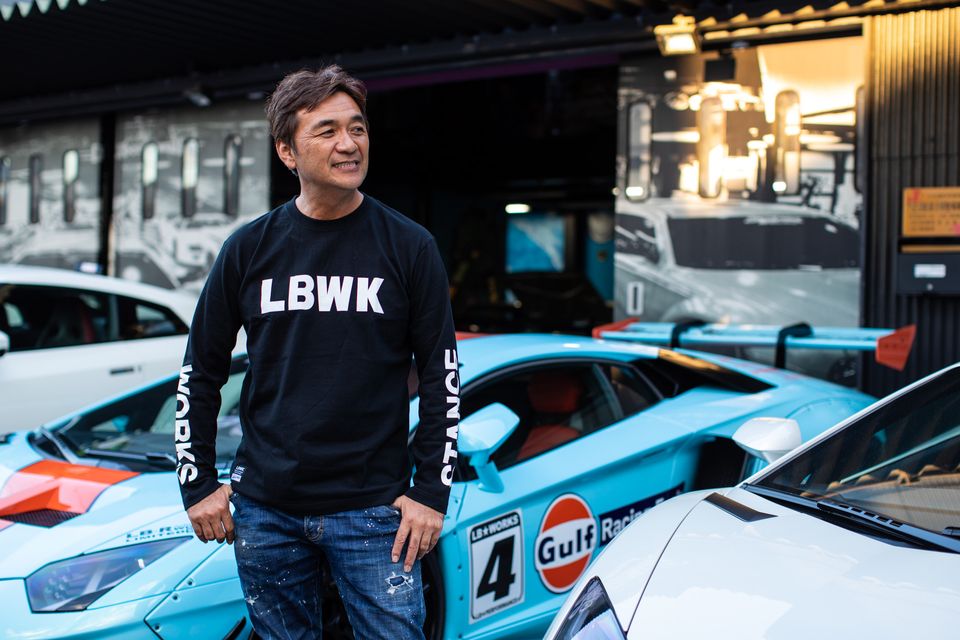Walking Freely with Wataru Kato

Liberty Walk. It is a household name on a global scale within the car scene for its legendary builds and larger-than-life owner, Wataru Kato. Kato-san’s work, as polarizing as it is loved, speaks for itself. Brave enough to angle grind a Lamborghini or slam a Ferrari mere centimeters above the ground, he answers to no one.
Fortunate enough to speak with Kato for a quick interview, I wanted to dive into the history of Liberty Walk. It is evident that Liberty Walk is much more than a car shop that has become known around the globe; it is a movement and cultural shift within the Japanese car modification scene on a large scale.
The idea of taking a car worth upwards of $500,000 and taking an angle grinder, band-saw, or other such tools directly to the body is looked at as mind-boggling to many, maybe even crazy. Not Kato, a figure revered by car fans internationally as a legend for his contribution to the tuner scene.
His influence is felt by many; not confined to just vehicle modifications. It encourages the tuner community to fulfill their dreams and pursue their artistic expressions, which may seem closer than they appear.
A very special thanks to Toshiro Nishio for translations.
Where was the inspiration coming from at an early age? Where did the interest of cars spawn from?
Of course, my father!
My senior and friends from school also contributed to being inspirations. Actually, I was not interested in car culture much during my childhood. I loved playing baseball or hanging out with friends, though. When my senior and older friends graduated from high school, they purchased and started to modify their cars.
It would be fair to say this is when I picked up an interest in doing so as well.
What impact did Japan’s car culture impact your approach to modifying cars or engineering?
Especially when it came to Japanese 暴走族 (Bōsōzoku) culture and Japanese street racing culture, I fell in love immediately.
I didn’t have much money to modify at the time. Due to this, I ended up having to purchase used parts and/or build them myself. I loved Japan’s old-school style and aesthetic; this influenced our signature rivet and wide fender style of modifying vehicles.
You founded Liberty Walk at 26. Do you like to take risks?
I don’t think I take risks; I always think if I try my best, I can do anything.
I love the business and industry. It was simple that I founded Liberty Walk at 26. Wataru means Walk in Japanese. I love the word Liberty, so I just put Walk after Liberty, because I would like to walk freely [in life]!
“Imagine all the people living life in peace” following the Hinomaru is found on many Liberty Walk cars. Why?
I took the phrase from John Lennon’s Imagine. The phrase is a policy I stand by as well.

Above, the World’s First Lamborghini drift build. A collaboration between Liberty Walk and Phat Five Racing, the Murciélago you see belongs to legendary drifter Daigo Saito. Sacrilegious or not, it proves to be one of the most powerful drift cars of its time, and Kato was behind the design. Perfectly catered to its purpose, aesthetically and technically.
This surgical and obsessive vibe wades itself through Japan’s society in many forms; it is a balance of art and knowledge. Above anything, though, it is culture. Kato utilizes this within his designs, while going against the grain and being a front-runner of a large cultural shift, seemingly increasing in both number and strength, each day.
Unity, instead of rebellion; something Kato encourages.
Although 26 at the time of founding Liberty Walk, Kato had a long history of modifying cars; this was not his first dance. Siphoning influence from go-to traditions of the Japanese car scene, he eventually graduated from Shakotan (シャコタン) to supercars, while still holding the former closest to his heart alongside Bōsōzoku culture. After all, it was his first passion. Shakotan means car that is lowered, and we’ll see how applies literally throughout Kato’s work later, when he speaks on his design philosophy.
Style and elegance, while remaining organized and reserved are aspects of Japanese car culture which are seldom found elsewhere at as-extreme levels as they are domestically. The Bōsōzoku culture was a counterculture movement culminated from a rising trend of rebellious activity. Aggressive in both execution and image, the motorbike gangs would act as salmon would in a river, weaving to and fro on city streets, highways, and large funnels of traffic. Feared, and also fearless, these gangs would act as a counterculture in Japan that arguably act as the genesis of a long-term societal shift.
With this in mind, Kato started small. A used garage and 3 cars, but the whole world in front of him.
You started with 3 cars that were on display at 26; where does it stand now?
Supercars that people see, are modified then put up for sale.
In regards to my personal collection, it is reserved for old-school Japanese cars which I’ve curated over the years.
Maybe around 20 cars at this point.
The reputation of Liberty Walk is that it is a legendary automotive shop on a global scale. It is regarded as one of the most respected shops in the world, and it is a crowd favorite. Did you envision this when you created Liberty Walk?
I never expected Liberty Walk to be this large. I just have a deep passion for modified cars and the industry which surrounds it. I just want to make my customers happy, and spread this culture of modifying and customizing cars to the younger generation.
Liberty Walk is considered a “supercar tuner” by many outlets that write about car modification.
We’re still a custom shop for any car; not just supercars. I just want to show the art of Japanese custom car culture to the world.
Hands-on and bespoke. A simple approach is what Kato wants the world to recognize his work as; he doesn’t want to be trapped within this cage that outlets have labelled him with. Sure, he works on supercars, but he’s not solely a supercar tuner.
The dissemination of knowledge is a key factor to Kato’s philosophy; above the designing, above the craftsmanship, and above the physical cars themselves. This spread of the culture he has played a massive part in is what he wants people to both hear and become involved in.
Unanimously, he has been one of the key players within modern Japanese car culture, both on the ground and in the virtual realm, amassing millions of followers across the Liberty Walk conduits.
With the explosion of social media within the last decade, consumption of content has become exponentially easier. Tuners in Japan are no longer restricted to borders, fans overseas are no longer struggling to find information about this movement.
On top of that, he’s going forward with a new line of kits that are catering to the more casual customer, allowing increased accessibility to high end materials and modifications; the LB ★ NATION line.
Kato is setting up the next generation to build upon this foundation that he and other big names have created. That’s a good thing, and should be recognized as such.
What’s the design philosophy and process behind the supercar kits?
My idea and approach is to draw from the old-school style of Japanese-based modification culture. Always respect the original car’s design, like on a Lamborghini or Ferrari, but add something unique. Our bestselling kit is for the Nissan GTR; the Avendator kit is the most iconic, however.
We’ve recently released a new style kit for the 458 and Huracan, the LB Silhouette WORKS GT line. It’s my belief that this will become the new iconic kit of Liberty Walk.
Liberty Walk uses custom digital air suspension systems in cars.
Yes, we use AIRREX. We always use AIRREX for all Liberty Walk cars.
Their air suspension makes the cars the lowest they can possibly be. Making cars low looks beautiful.
Air suspension is an incredibly difficult feat to achieve where the fitment of the overfenders appear to be seamless, and a rare sight to see for cars of this grade.
Kato employs a down-to-earth feeling to all of his designs. Some may argue form over function, but I’m more subscribed to the notion that Liberty Walks finds a satisfying balance between the two.
It’s no doubt that the air suspension system also provides function. Top quality and in some cases costing upwards of $15,000, this is no child’s toy. It’s a high-grade air management system that improves handling and turning radius of a vehicle, containing several pressure presets and bolt-on air struts to adjust both damper and drop when aired completely out. This attention to minute details allows customers to use their modified vehicles as they want, something that Kato holds to high standards and priority.
Liberty Walk and Kato’s association with those two words are synonymous with Japanese car culture for good reason, striking a balance of technical and visual beauty, which is seldom achieved.
One build was especially meaningful; the F CANCR GTR you did for Andrew. Could you speak on how you two met?
He had dream which he would like to acquire a custom Liberty Walk GTR; despite having cancer at the time, it did not faze him. When I met him at SEMA, he had a huge amount of positive energy and would never give up.
I really liked his positive attitude, and it was a great moment when I met him and found out about his dream.
Rest in peace, Andrew.
Favorite car ever that you own or have worked on?
My Nissan ケンメリ (Kenmeri/Ken&Mary), the sky blue one.
Akira Nakai (RWB) and Kei Miura (Rocket Bunny/Pandem). Legends in the game as well.
We are good friends; of course, I respect their work, which is great.
Each of their styles are totally different!
In an interview with PasMag, Kato goes on to expand further about the relationship between him, Kei, and Akira; widely-regarded as the 3 Kings when it comes to anything tuner-related in Japan:
[Kei] Miura of Rocket Bunny and I work together through the production phase. Liberty Walk’s LB Performance is a collaboration of Miura’s design and my own. The design is not biased strongly towards either of our designs – we take good ideas from each of our designs so we get along really well.
…
Including [Akira] Nakai (of RWB), we are all old school car enthusiasts. We don’t have concerns about each other and we just recognize each other’s talent. That is why all three of us get along very well.
It’s clear as we delve into the scene that there’s a movement occurring. Sure, the focus is on producing top shelf quality builds and final results that will make magazine covers and win awards at shows, but beneath it is this teamwork between the figureheads of the scene. This yearning to revitalize a culture that is being lost in many parts of the world, and the fearlessness of metamorphosis.
It is not so much an achievement of status or success, as it is self-determination and motivation. That’s something which is precisely reckoned.
Japan is known globally for the incredible car scene. The people of Japan love cars and have appreciation for the engineering and design. Why do you think this is?
Japan has a long history of many people passing down this culture (and other cultural things) to the next generation. We know how fun modified cars are; it’s as simple as that.
My home’s in Seoul. As you know, the society here makes it difficult to express personal feelings. Do you think since Japan is similar, that cars may be used as a conduit to do so? Thoughts on Korea’s car scene?
I think personality between Japanese and Korean people is similar. Korean people have good taste when it comes to modified cars, too.
However, Korean traffic laws are very strict. When I went to Korea a few years ago and visited car shops and whatnot, they were interested in modifying their cars, but the culture has just started in Korea. It’s going step by step.
I think it needs some time [to grow]. It’s my hope that the industry expands more and more, soon.
As we spoke about the parallels Japan and Korea have in regards to their societal structures, pressures, and the car scene in Seoul being in its infancy, I kept reflecting and coming back to this answer.
High-pressure and somewhat suppressible, culture in Japan and Korea is slowly making progress, but has remnants of a time where self-expression was severely hindered. Encouraged from adolescence to follow form, be a chameleon in every day situations, and never fail, expressing one’s personality is more hidden than seen.
In a strange yet rebellious way, customizing a car over in these parts is showing the world your personality and removing the mask of every day assimilation. Passive, but effective.
Many would say you’re an artist; others would say just a car person. What do you consider yourself?
I’m just an old guy that owns a car shop; I never think of myself as an artist.
Liberty Walk is now a global brand, and it is at the top. Many say it is the best. What’s next?
I still have many ideas. My ideas are not limited to cars. No limits.
What do you want your legacy to be?
I think Liberty Walk culture will be my legacy. Our culture is very important for me. Culture to me means my taste of modified cars and taking care of customers.
How long will you continue to operate Liberty Walk?
No idea. I’m just doing my best every day.
Despite the tears of purists, the praise and cheers Kato receives on an international scale easily overwhelms the negative feedback. He is often seen attending car shows and meet-and-greets, standing as the life of the party. Being a figurehead of Japan’s tuner culture, Kato is confident and bold, and will continue to pursue his passion. No one can fault him, as his work has shaken the industry for its level of expertise.
Not an artist, but a craftsman. A master of car modification, among the best in the world, yet he remains down to earth. Humble and stoic in form, yet outgoing and heartwarming in personality, it’s this balance that seems to apply to everything in Kato’s life.
His legacy will be that of Liberty Walk culture, and the most important thing to extract from that is the willpower to succeed and achieve dreams that may seemingly be out of reach or too far gone. The cars come second.
His work knows no bounds. Cars are just a branch of what he has planned, and the world is ready and waiting to see what he has coming up.
Wataru Kato, Japan’s King of Style.



